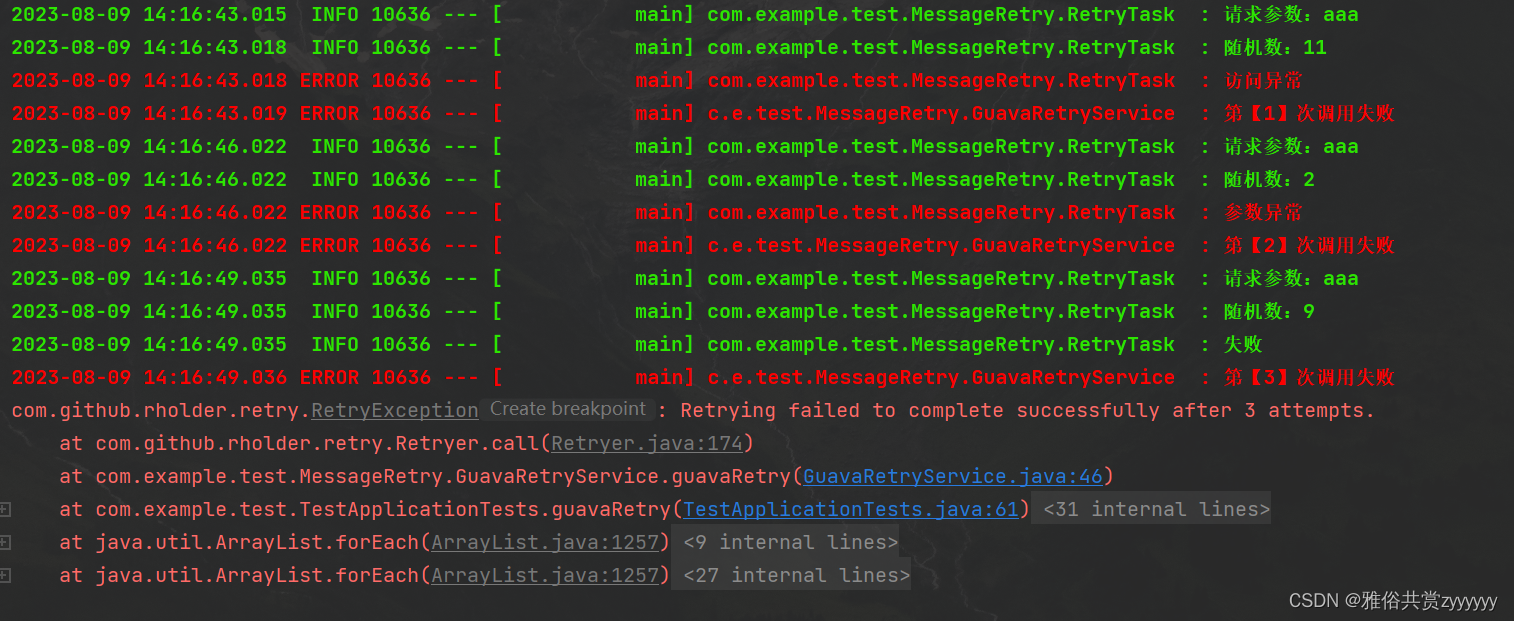前言
在日常工作中,随着业务日渐庞大,不可避免的涉及到调用远程服务,但是远程服务的健壮性和网络稳定性都是不可控因素,因此,我们需要考虑合适的重试机制去处理这些问题,最基础的方式就是手动重试,侵入业务代码去处理,再高端一点的通过切面去处理,较为优雅的实现重试,下面,介绍两个重试框架,只需要配置好重启策略及重试任务,即可使用。
重试任务
这里只是模拟传参、相应及异常,具体任务需对应业务
package com.example.test.MessageRetry;
import lombok.extern.slf4j.Slf4j;
import org.apache.commons.lang3.RandomUtils;
import org.springframework.remoting.RemoteAccessException;
@Slf4j
public class RetryTask {
/**
* 重试方法
* @param param
* @return
*/
public static boolean retryTask(String param){
log.info("请求参数:{}",param);
int i = RandomUtils.nextInt(0,15);
log.info("随机数:{}",i);
if(i == 0){
log.error("参数异常");
throw new IllegalArgumentException("参数异常");
}else if(i > 10){
log.error("访问异常");
throw new RemoteAccessException("访问异常");
}else if(i % 2 == 0){
log.info("成功");
return true;
}else{
log.info("失败");
return false;
}
}
}
Spring-Retry
简介
Spirng-Retry是Spring提供的一个重试框架,为spring程序提供声明式重试支持,主要针对可能抛出异常的调用操作,进行有策略的重试。可以通过代码方式和注解方式实现,主要由重试执行者和两个策略构成:
RetryTemplet:重试执行者,可以设置重试策略(设置重试上线、如何重试)和回退策略(立即重试还是等待一段时间后重试,默认立即重试,如果需要配置等待一段时间后重试则需要指定回退策略),通过Execute提交执行操作,只有在调用时抛出指定配置的异常,才会执行重试
重试策略:
策略方式NeverRetryPolicy只允许调用RetryCallback一次,不允许重试AlwaysRetryPolicy允许无限重试,直到成功,此方式逻辑不当会导致死循环SimpleRetryPolicy固定次数重试策略,默认重试最大次数为3次,RetryTemplate默认使用的策略TimeoutRetryPolicy超时时间重试策略,默认超时时间为1秒,在指定的超时时间内允许重试ExceptionClassifierRetryPolicy设置不同异常的重试策略,类似组合重试策略,区别在于这里只区分不同异常的重试CircuitBreakerRetryPolicy有熔断功能的重试策略,需设置3个参数openTimeout、resetTimeout和delegateCompositeRetryPolicy组合重试策略,有两种组合方式,乐观组合重试策略是指只要有一个策略允许即可以重试,悲观组合重试策略是指只要有一个策略不允许即可以重试,但不管哪种组合方式,组合中的每一个策略都会执行重试回退策略:
回退策略方式NoBackOffPolicy无退避算法策略,每次重试时立即重试FixedBackOffPolicy固定时间的退避策略,需设置参数sleeper和backOffPeriod,sleeper指定等待策略,默认是Thread.sleep,即线程休眠,backOffPeriod指定休眠时间,默认1秒UniformRandomBackOffPolicy随机时间退避策略,需设置sleeper、minBackOffPeriod和maxBackOffPeriod,该策略在minBackOffPeriod,maxBackOffPeriod之间取一个随机休眠时间,minBackOffPeriod默认500毫秒,maxBackOffPeriod默认1500毫秒ExponentialBackOffPolicy指数退避策略,需设置参数sleeper、initialInterval、maxInterval和multiplier,initialInterval指定初始休眠时间,默认100毫秒,maxInterval指定最大休眠时间,默认30秒,multiplier指定乘数,即下一次休眠时间为当前休眠时间*multiplierExponentialRandomBackOffPolicy随机指数退避策略,引入随机乘数可以实现随机乘数回退此外,还需要配置重试时间间隔、最大重试次数以及可重试异常
实现
代码方式
RetryTemplate通过execute提交执行操作,需要准备RetryCallback和RecoveryCallback两个类实例,前者对应的就是重试回调逻辑实例,包装正常的功能操作,RecoveryCallback实现的是整个执行操作结束的恢复操作实例,只有在调用的时候抛出了异常,并且异常是在exceptionMap中配置的异常,才会执行重试操作,否则就调用到excute方法的第二个执行方法RecoveryCallback中
package com.example.test.MessageRetry;
import lombok.extern.slf4j.Slf4j;
import org.junit.jupiter.api.Test;
import org.springframework.remoting.RemoteAccessException;
import org.springframework.retry.annotation.Backoff;
import org.springframework.retry.annotation.Recover;
import org.springframework.retry.annotation.Retryable;
import org.springframework.retry.backoff.FixedBackOffPolicy;
import org.springframework.retry.policy.SimpleRetryPolicy;
import org.springframework.retry.support.RetryTemplate;
import org.springframework.stereotype.Service;
import java.util.HashMap;
import java.util.Map;
@Service
@Slf4j
public class SpringRetryService {
/**
* 重试时间间隔ms,默认1000ms
*/
private long retryPeriodTime = 5000L;
/**
* 最大重试次数
*/
private int maxRetryNum = 3;
/**
* 哪些结果和异常要重试,key表示异常类型,value表示是否需要重试
*/
private Map<Class<? extends Throwable>,Boolean> retryMap = new HashMap<>();
@Test
public void test(){
retryMap.put(IllegalArgumentException.class,true);
retryMap.put(RemoteAccessException.class,true);
//构建重试模板
RetryTemplate retryTemplate = new RetryTemplate();
//设置重试回退操作策略,主要设置重试时间间隔
FixedBackOffPolicy backOffPolicy = new FixedBackOffPolicy();
backOffPolicy.setBackOffPeriod(retryPeriodTime);
//设置重试策略,主要设置重试次数
SimpleRetryPolicy retryPolicy = new SimpleRetryPolicy(maxRetryNum,retryMap);
retryTemplate.setRetryPolicy(retryPolicy);
retryTemplate.setBackOffPolicy(backOffPolicy);
Boolean execute = retryTemplate.execute(
//RetryCallback
retryContext -> {
boolean b = RetryTask.retryTask("aaa");
log.info("调用结果:{}",b);
return b;
},
retryContext -> {
//RecoveryCallback
log.info("到达最多尝试次数");
return false;
}
);
log.info("执行结果:{}",execute);
}
}

注解方式
上面我们说到Spring-Retry是Spring提供的,那么,它就支持依赖整合
<!--spring-retry-->
<dependency>
<groupId>org.springframework.retry</groupId>
<artifactId>spring-retry</artifactId>
<version>1.2.2.RELEASE</version>
</dependency>
<dependency>
<groupId>org.aspectj</groupId>
<artifactId>aspectjweaver</artifactId>
<version>1.9.1</version>
</dependency>
然后,在启动类上添加开启注解
//表示是否开启重试,属性proxyTargetClass,boolean类型,是否创建基于子类(CGLIB)的代理,而不是标准的基于接口的代理,默认false
@EnableRetry
package com.example.test.MessageRetry;
import lombok.extern.slf4j.Slf4j;
import org.apache.commons.lang3.RandomUtils;
import org.springframework.remoting.RemoteAccessException;
@Slf4j
public class RetryTask {
/**
* 重试方法
* @param param
* @return
*/
public static boolean retryTask(String param){
log.info("请求参数:{}",param);
int i = RandomUtils.nextInt(0,15);
log.info("随机数:{}",i);
if(i >-1){
log.error("参数异常");
throw new IllegalArgumentException("参数异常");
// }else if(i > 10){
// log.error("访问异常");
// throw new RemoteAccessException("访问异常");
// }else if(i % 2 == 0){
// log.info("成功");
// return true;
}else{
log.info("失败");
return false;
}
}
}
/**
* 重试调用方法
* @param param
* @return
* @Retryable注解:
*
*/
@Retryable(value = {RemoteAccessException.class,IllegalArgumentException.class},maxAttempts = 3,backoff = @Backoff(delay = 5000L,multiplier = 2))
public void call(String param){
RetryTask.retryTask(param);
}
/**
* 达到最大重试次数,或抛出了没有指定的异常
* @param e
* @param param
* @return
*/
@Recover
public void recover(Exception e,String param){
log.error("达到最大重试次数!!!!!");
}
@Test
public void retry(){
springRetryService.call("aaa");
}
@Retryable注解说明
属性说明value指定重试的异常类型,默认为空maxAttempts最大尝试次数,默认3次include和value一样,默认为空,当exclude也为空时,默认所有异常exclude指定不处理的异常Backoff重试策略@Backoff注解说明:设定重试倍数,每次重试时间是上次的n倍
属性说明delay重试之间的等待时间(以毫秒为单位),默认0maxDelay重试之间的最大等待时间(以毫秒为单位),默认0multiplier延迟的倍数,默认0.0delayExpression重试之间的等待时间表达式,默认空maxDelayExpression重试之间的最大等待时间表达式,默认空multiplierExpression指定延迟的倍数表达式,默认空random随机指定延迟时间,默认false@Recover注解说明:当重试到达指定次数时,将要回调的方法
@Retryable和@Recover修饰的方法要在同一个类中,且被@Retryable和@Recover标记的方法不能有返回值,这样Recover方法才会生效。由于@Retryable注解是通过切面实现的,因此我们要避免@Retryable 注解的方法的调用方和被调用方处于同一个类中,因为这样会使@Retryable 注解失效。
 我们可以看到,Spring-Retry只能针对指定异常重试,不能根据执行结果返回值重试,整体使用也比较死板,下面,看下更加灵活的Guava-Retry。
我们可以看到,Spring-Retry只能针对指定异常重试,不能根据执行结果返回值重试,整体使用也比较死板,下面,看下更加灵活的Guava-Retry。
Guava-Retry
简介
Guava-Retry是谷歌的Guava库的一个小扩展,允许为任意函数调用创建可配置的重试策略,我们可以通过构建重试实例RetryBuilder,来设置重试源、配置重试次数、重试超时时间、等待时间间隔等,实现优雅的重试机制。
主要属性
属性说明attemptTimeLimiter时间限制策略,单次任务执行时间限制,超时终止stopStrategy停止重试策略waitStrategy等待策略blockStrategy任务阻塞策略,即当前任务执行完,下次任务执行前做什么,仅有线程阻塞threadSleepStrategyretryException重试异常(重试策略)listeners自定义重试监听器,可用于记录日志等时间限制策略
策略说明NoAttemptTimeLimit对代理方法不添加时间限制,默认FixedAttemptTimeLimit对代理方法的尝试添加固定时间限制重试策略(重试异常)
策略说明retryIfException抛出 runtime 异常、checked 异常时都会重试,但是抛出 error 不会重试retryIfRuntimeException只会在抛 runtime 异常的时候才重试,checked 异常和error 都不重试retryIfExceptionOfType允许我们只在发生特定异常的时候才重试,比如NullPointerException 和 IllegalStateException 都属于 runtime 异常,也包括自定义的errorretryIfResult可以指定你的 Callable 方法在返回值的时候进行重试停止策略
策略说明StopAfterDelayStrategy设定最长执行时间,无论任务执行几次,一旦超时,任务终止,返回RetryExceptionStopAfterAttemptStrategy设定最大尝试次数,一旦超过,返回重试异常NeverStopStrategy一直轮询直到获取期望结果等待策略
策略说明ExceptionWaitStrategy异常时长等待,如果抛出的是指定异常,则从传入的方法中取得等待时间并返回;如果异常不匹配,则返回等待时间为0LCompositeWaitStrategy复合时长等待,在获取等待时间时会获取多种等待策略各自的等待时间,然后累加这些等待时间FibonacciWaitStrategy斐波那契等待策略ExponentialWaitStrategy指数等待时长,指数增长,若设置了最大时间,则停止,否则到Long.MAX_VALUEIncrementingWaitStrategy递增等待,提供一个初始时长和步长,随次数叠加RandomWaitStrategy随机等待时长,可以提供一个最大和最小时间,从范围内随机FixedWaitStrategy固定等待时长代码
<!--guava-retryer-->
<dependency>
<groupId>com.github.rholder</groupId>
<artifactId>guava-retrying</artifactId>
<version>2.0.0</version>
</dependency>
package com.example.test.MessageRetry;
import lombok.extern.slf4j.Slf4j;
import org.apache.commons.lang3.RandomUtils;
import org.springframework.remoting.RemoteAccessException;
@Slf4j
public class RetryTask {
/**
* 重试方法
* @param param
* @return
*/
public static boolean retryTask(String param){
log.info("请求参数:{}",param);
int i = RandomUtils.nextInt(0,15);
log.info("随机数:{}",i);
if(i < 3){
log.error("参数异常");
throw new IllegalArgumentException("参数异常");
}else if(i > 10){
log.error("访问异常");
throw new RemoteAccessException("访问异常");
}else if(i % 2 == 0){
log.info("成功");
return true;
}else{
log.info("失败");
return false;
}
}
}
package com.example.test.MessageRetry;
import com.github.rholder.retry.*;
import com.google.common.base.Predicates;
import lombok.extern.slf4j.Slf4j;
import org.springframework.remoting.RemoteAccessException;
import org.springframework.stereotype.Service;
import java.util.concurrent.TimeUnit;
@Service
@Slf4j
public class GuavaRetryService {
public void guavaRetry(){
//构建重试实例RetryBuilder,可以设置重试源,可以配置重试次数、重试超时时间、等待时间间隔
Retryer<Boolean>retryer = RetryerBuilder.<Boolean>newBuilder()
//设置异常重试源
.retryIfExceptionOfType(RemoteAccessException.class)
.retryIfExceptionOfType(IllegalArgumentException.class)
//设置根据结果重试 res->res==false Predicates.containsPattern("_error$")
.retryIfResult(Predicates.equalTo(false))
//设置等待时间
.withWaitStrategy(WaitStrategies.fixedWait(3, TimeUnit.SECONDS))
//设置最大重试次数
.withStopStrategy(StopStrategies.stopAfterAttempt(3))
//设置重试监听,可用作重试时的额外动作
.withRetryListener(new RetryListener() {
@Override
public <V> void onRetry(Attempt<V> attempt) {
log.error("第【{}】次调用失败",attempt.getAttemptNumber());
}
})
//设置阻塞策略
.withBlockStrategy(BlockStrategies.threadSleepStrategy())
//设置时间限制
.withAttemptTimeLimiter(AttemptTimeLimiters.noTimeLimit())
.build();
try{
retryer.call(()->RetryTask.retryTask("aaa"));
}catch (Exception e){
e.printStackTrace();
}
}
}

可以看到,我们设置了重试三次,超过这个限制没有执行成功,抛出了重试异常,而且也可以根据我们的返回结果来判断。
总结
Spring-Retry和Guava-Retry都是线程安全的重试框架,能够保证并发业务下重试逻辑的正确性。两者都很好的将正常方法和重试方法进行了解耦,可以设置超时时间、重试次数、间隔时间、监听结果等,相比来说,Guava-Retry比Spring-Retry更加灵活,并且可以通过返回值来进行重试,两者都是非常好的重试框架,具体的选用看相关的业务场景即可。
版权归原作者 雅俗共赏zyyyyyy 所有, 如有侵权,请联系我们删除。